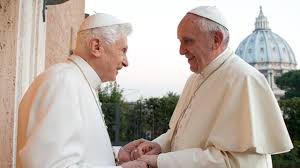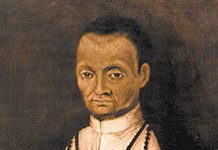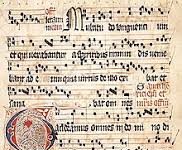It is a curious situation in the Church that we have two living Popes, one of them a resigned, retired Pope ’emeritus’. One is reminded of the situation from 1294 to 1296, when Pope Celestine V, a monk whom the cardinals had made Pope to help reform the papacy, resigned, with the new Pope, Boniface VIII, locking him up in the Vatican to avoid his kidnapping, and possible schism. Celestine did not mind, seeing his imprisonment as a different kind of monasticism.
In the current case, there is much that could be said of our new two Popes, but one thing we may ponder are the two primal gifts they display: Francis, from the ”charismatic area of the Church” and Benedict XVI from the magisterial (hierarchical) area of the Church.
In his presentation of the Letter to Bishops, “The Church rejuvenates”, on the relationship between hierarchical and charismatic gifts for the life and mission of the Church, Cardinal Marc Ouellet, prefect for the Congregation for Bishops, said that ”the growing vitality of new movements, groups of faithful and ecclesial communities, along with the need to specify the collocation of consecrated life within the Church” has led the post-Conciliar Magisterium to multiply its interventions in this regard. He recalled that ‘”St. John Paul II coined the principle of the ‘co-essentiality’ of these gifts, which was reaffirmed and explored further by Benedict XVI and by Pope Francis when he reiterated that these gifts have the same origin in the Holy Spirit, which actuates the ‘harmony’ between them, ensuring their ecclesial integration and their missionary openness.”
Cardinal Ouellet concluded his presentation by saying that “If anyone were still to doubt the relevance of the charismatic dimension in the Church, (he) would invite them to reflect on the fact that fifty years after Vatican Council II, the Holy Spirit and the cardinals chose a supreme pastor who comes from the charismatic area of the Church.” Of course, Cardinal Ouellet was referring to Pope Francis. Could we not also say that Benedict XVI, who is still part of the papacy, although not as the Sovereign Pontiff responsible for the administration of the Church, remains endowed with the supreme magisterial gift necessary for the edification of the Church, the Body of Christ?
When Pope Francis visited Naples in March of last year, the coagulated blood of the martyred bishop Saint Januarius liquefied in its ampule even though this miracle traditionally happens only on September 19, December 16 and the Saturday before the first Sunday of May. There might have been a meaning attached to this anachronism, but more significant, in my view, is that only half of the blood contained in the glass ampule liquefied. Is it possible to attribute this half-liquification to Pope Francis’ papacy, indicating that it is only half of the whole, which includes that of Pope Benedict’s?
It is said that ”the Church must breathe with two lungs” those of the Catholic and Orthodox Churches. Pope Francis has only one lung. Could the allegory of the Church’s ‘lungs’ be extended to the two popes? Could it be said that the papacy (in its present and actual sense) is one and that each pope is half the papacy?
Also, one might wonder if Benedict XVI is the pope emeritus of the Catholic Church or simply the bishop emeritus of Rome?
Another question: In the case of an eventual reunion with the Orthodox churches, what would be, then, the significance of the Pope of the Coptic Orthodox Church of Alexandria? Would we make reference to him as ‘”the Pope who is in Alexandria”? Is the name-loan ”pope” merely a title or a word having the same extension as ‘father’?
I would think that, given the ramifications, the theological and canonical implications of having two or more validly elected and concurrently reigning popes should be examined.











